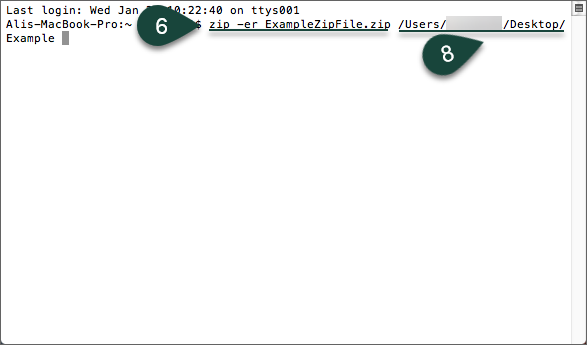combines many functions in a single, portable executable that belongs onto every USB stick.Search and convert text files, instant simple FTP/HTTP server, find duplicate files, compare folders, treesize, run own commands on all files of a folder - it's all within a single tool.Read the list of highlight features. | |
| Download SFK for Windows here or from SourceForge.For SFK x64 read more here.You may also download the .zip file with all binaries and source code for Windows (7/Vista/XP), Linux and Mac, the Intel Linux binary for 64 bits Ubuntu, for 32 bits Intel Linux, the binary for libc5 systems like DSL, for 32 bits ARM Linux like on Raspberry Pi, the Mac OS X binaries as i686 exe or for PowerPC. No installation, instant use. | |
- Zip A File In Mac Terminal File
- Zip File Mac Terminal With Password
- Zip A File In Mac Terminal Linux
- Zip A File In Mac Terminal


The zip command included with Mac OS X does offer a way to encrypt zip files without using any third-party software. However, like the password-protection feature built into Windows XP, it uses the old and insecure standard zip encryption scheme. If you really wanted, you could use the “zip -e” command in a Terminal on a Mac. ITerm2 is a terminal emulator for Mac OS X that does amazing things. gnachman/iTerm2.
| Get the Five Dollar Book!All commands in a 300 page PDF, for convenient reading on your tablet, smartphone,or for self printing. Includes a 60 page tutorial for the most important functions. |
- First, open up a terminal window. Once the terminal window is open, follow the command-line examples below to learn how to compress files with the zip command. To compress a folder containing files with the Zip tool, specify the location of the folder to the zip command. Keep in mind that you will need to customize the command example below to.
- Windows: after download, open a command line (CMD.exe) then CD into the download folder and type 'sfk' for the help text. Mac/Linux: after download, open a command line or terminal, then rename to sfk like 'mv sfk-mac-64.exe sfk', make it executable by 'chmod +x sfk' and type './sfk'.
- Create a password-protected ZIP file in OS X. To create a password-protected Zip file in OS X, you can use the Terminal and you don’t need to download any other programs. First, place all of the files that you want to compress into a single folder, and then rename that folder to the name that you want your ZIP file to have. Open the Terminal.
Windows | Linux | Mac OS X |
Intense users may be interested in Swiss File Knife Plus. It features a high performance replace command for large text and binary files, can access https:// encrypted web URLs, and comes bundled with SFKTray Full to show 27 status lights in the system tray. Read more here.
The current version is 1.9.7.2. Read the list of recent changes here.
 You may place questions in the sfk forums.
You may place questions in the sfk forums. 
Zip A File In Mac Terminal File
 For software download sites: the SFK PAD file is available here.
For software download sites: the SFK PAD file is available here.Zip File Mac Terminal With Password
SFK Icons and example code for linking can be found here.
Now follows the SFK for Windows syntax overview.(On Mac OS X and Linux, replace every ! character by :, and every $ by #. Type wildcardswith a preceeding slash: * and ?)| Get the Five Dollar Book!All commands in a 300 page PDF, for convenient reading on your tablet, smartphone,or for self printing. Includes a 60 page tutorial for the most important functions. |
Zip A File In Mac Terminal Linux
Zip A File In Mac Terminal
